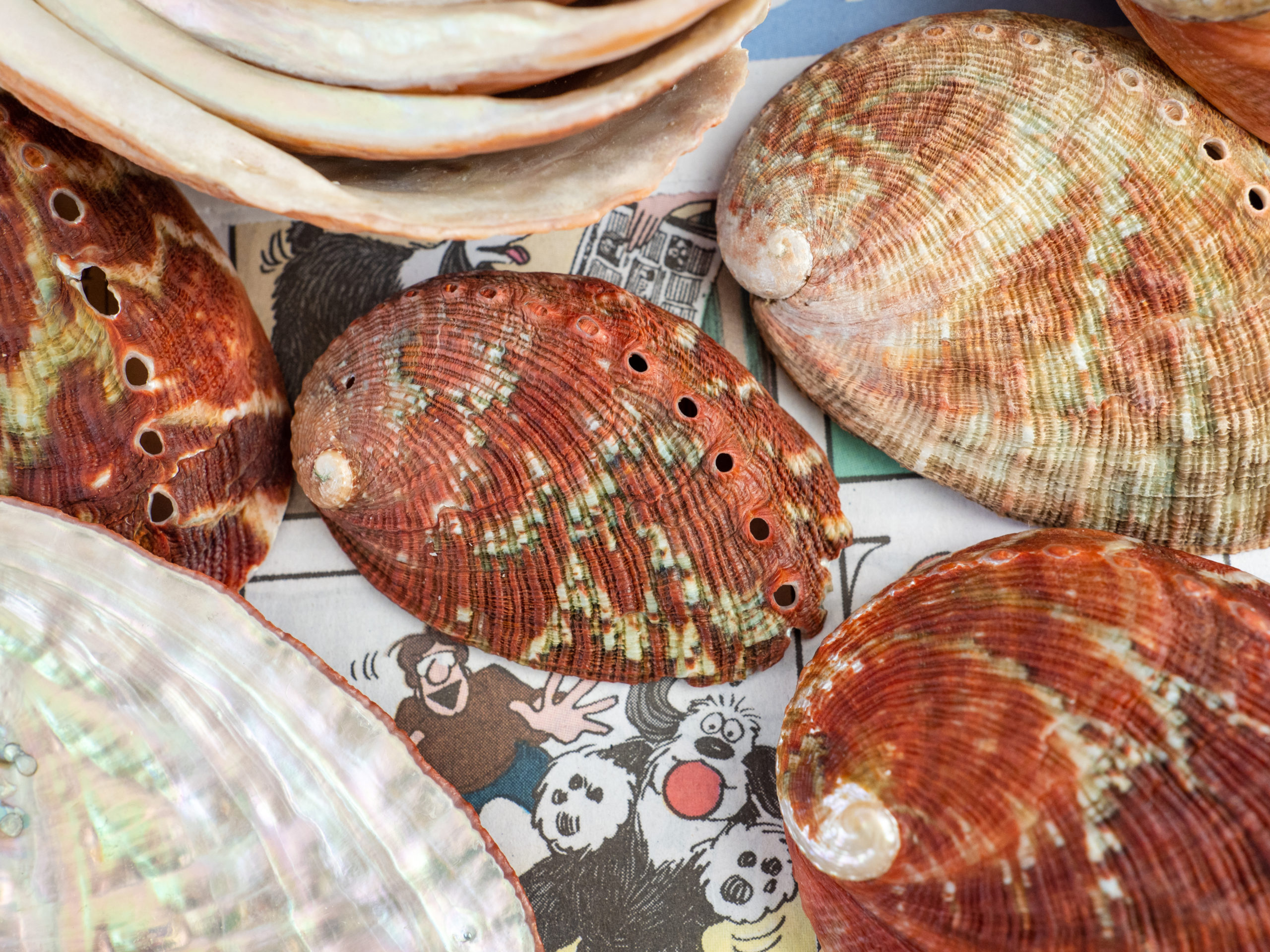
The Elusive Flat Abalone: Few & Far Between
By: Oriana Poindexter, Founder & Principal, Pelagic Projects
This blog is the fifth in a series, The Iridescent Ones: Visualizing California’s Abalone. Read part one of this blog series, Extreme Tidepooling for Black Abalone on California’s Central Coast, in which Oriana goes searching for black abalone. Part two of this blog series, Scuba Diving for White Abalone at the “Hotspot”, discusses Oriana’s search for white abalone. In part three of this blog series, Diving Into Abalone Habitat: Channel Islands National Marine Sanctuary, Oriana searches for abalone during a day of diving in the Channel Islands. Part four of this blog series, Into the Wild: Exhibit Creation with the Aquarium of the Pacific, showcases the creation of Oriana’s recent photography exhibition in Long Beach, California.
The waters off the Pacific Coast of North America are home to seven species of abalone, some more famous than others. When I talk to people about them, it’s usually the red abalone that comes up first, top of mind for many as the most recently harvested species and the one cultivated as an aquaculture product in California.
The white and black abalone might come up next, more widely known today because of their federally endangered status and tendency to pop up in news headlines. Folks might then slowly come up with the green, pink, or pinto abalone. I don’t think I’ve met anyone outside the scientific abalone world that has managed to recall the name of the final species in our complex – the flat abalone (Haliotis walallensis).
A Google Scholar search for Haliotis walallensis in the title of a research paper yields only two search results. One of these is a 1974 piece written by a commercial abalone diver titled, “In search of the elusive Haliotis walallensis” . This single page of text in the Conchologists of America Bulletin describes the flat abalone as “very shy…spends its entire life clinging to the undersides of large, flat boulders”. The piece ends with a polite reminder to the reader to please return any overturned boulders back to their original position when searching for this most elusive of abalone [1].
Little research effort has been focused on this seventh species. Flat abalone were described as a species in 1899, and range from Newport, Oregon to San Benito Island, Baja California [2]. Their scientific name is a reference to the Indigenous name of the Northern California town of Gualala, where the first described specimens were found [3]. Infrequently encountered, likely due to their ‘shy’ nature, they have always been considered rare [4]. The only time flat abalone were expressly targeted by a fishery was a brief attempt in Oregon, with a single permit issued from 2001 to 2008 [5].
I had set out to document all seven abalone species, wanting to be both complete and inclusive. In the summer of 2021, I needed, relatively urgently, to get my hands on at least the shell of a flat abalone to photograph to complete the design of a set of Abalone Identification Cards before an approaching deadline.
Based in San Diego, I didn’t anticipate this task to be too daunting. I just needed one shell, after all. San Diego is situated within the flat abalone’s historic geographic range, it is home to many abalone scientists and enthusiasts, and is also home to the massive marine specimen collection at the Scripps Institution of Oceanography (SIO).
A leading abalone geneticist, when asked for advice on where I may be able to find a flat abalone to photograph for this project, threw up his hands and laughed. Wishing me luck, he called them ‘unicorns’, and logged off the Zoom call laughing to himself about the prospect of finding a flat abalone.
As I continued to ask around, I got more responses like that of the laughing geneticist. A local commercial sea urchin diver, with decades of experience underwater, had never seen one and didn’t know their range extended this far south.
The only two flat abalone shells I managed to track down in Southern California didn’t make the cut. A colleague out of the NOAA Fisheries Long Beach office had one shell with a hole through it, and SIO had one intact shell, across which someone had written the word “FLAT” in large capital letters with a permanent marker. Lovely.
To meet my deadline, I tacked on a quick drive up to the UC Davis Bodega Marine Lab during a conveniently timed trip to San Francisco to visit friends in July 2021. A lunchtime visit yielded the shells I had been searching for, thanks to Shelby Kawana, the White Abalone Technician and Assistant Dive Safety Officer for the lab. I met her at the back of her pickup truck, where she carefully handed me a box of her own shells, collected over a lifetime of diving in Northern California, and ran back into a class she was teaching.
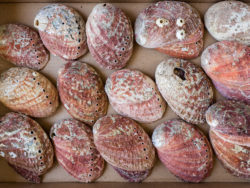
Flat abalone shells, Arjay Raffety’s personal collection. Photo credit: Oriana Poindexter
I found a spot on the lab’s campus to set up my lightbox and camera, crouching down to open Shelby’s box. Inside were a handful of flat abalone shells, the first I’d ever seen with my own eyes. They are relatively small, fitting neatly in the palm of my hand, and noticeably flatter than other abalone shells. Their exteriors sport intricate patterns and gorgeous, subtle rippling in the interior nacre. I took my photos, returned Shelby’s box, and went on my way.
Ten months passed in a flash, and again, I found myself up against a deadline with little progress made on the flat abalone front. I reached out to Arjay Raffety, who I had connected with back in 2021, in hopes of learning more, and perhaps the chance to do some diving to photograph flat abalone in the waters off Central California. While arranging for a visit, Arjay assured me that even if the conditions weren’t right for a dive, he’d be happy to share his experiences with flat abalone. In an email, he alluded to a ‘shell room’.
Abalone lovers generally give themselves away with their home and garden decor, myself included. There’s usually a few shells outside, either embedded into the walls of the house or tucked into the garden. Mr. Raffety is no different, and I knew I’d arrived at the right address when I saw an abalone shell mobile hanging outside the front door.
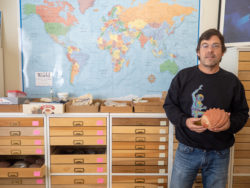
Mr. Raffety with a portion of his global abalone shell collection. Photo credit: Oriana Poindexter
Arjay Raffety is a retired aerospace engineer and a full-fledged abalone enthusiast. An avid diver and abalone identification expert, he is occasionally called upon to assist with federal and state scientific abalone surveys. Arjay has amassed a formidable collection of abalone shells from around the globe, beginning with the shells he collected as a child, tidepooling with his father.
Once I got inside, the scope of Arjay’s abalone collection began to reveal itself. There were green abalone shells in the entryway, a six foot tall glass display cabinet filled with red shells, and a few miscellaneous abalone shells displayed on the mantle. As we start talking, Arjay admits that not only does he have a shell room for his collection, but also a shell shed, for overflow.
The shell room is upstairs. One wall is lined by wooden specimen cabinets, each with a sticky note on the top right corner describing its contents. A table in the center holds boxes with shells that are actively being cataloged, and a bookshelf inside the doorway holds reference materials, and of course, more shells.
Abalone shells are famously beautiful, and Arjay’s are especially so. Scrubbed clean of encrusting organisms, drawer after drawer of colorful abalone shells from around the globe gleamed out at me. The colors of the exteriors are bold, especially the drawers of pintos, arranged by their various types – orange, red, green, even blue in their colorful ribbing.
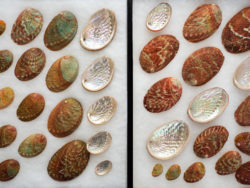
Flat abalone shells, Arjay Raffety’s personal collection. The shells on the right were collected in Central California, while those on the left were found in Northern California. Photo credit: Oriana Poindexter
The photographer in me is bug-eyed at this point. Trying to remain on task, I ran out to my car to get my photo equipment while Arjay pulled out boxes of flat abalone shells. Boxes, plural. While I had struggled to find a single intact flat abalone shell back in July 2021, in front of me now were at least one hundred flat abalone shells. Arjay had been carefully gathering these rare shells, one by one, for over forty years while tidepooling and diving in Central and Northern California. He explains that while he did occasionally eat a red abalone while it was legal to harvest them recreationally, none of the flat abalone shells in his collection were taken live.
Arjay stores his shells by species, and then in a sort of tiered system dependent on condition. For the flat abalone, the most beautiful shells are stored in two display cases. One case holds flats from Central California, and the other holds flat abalone shells found north of San Francisco Bay. The exterior coloration of the shells from the two regions are noticeably different, where the Central California shells are more intricately patterned with green and white tile-like detailing, the northern flats are more brick red, less detailed.
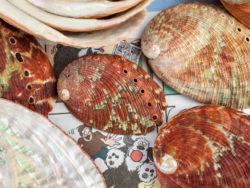
Flat abalone shells, Arjay Raffety’s personal collection. Photo credit: Oriana Poindexter
Next is a box of clean flat shells that didn’t make the cut for the display cases. Their interiors gleam under the light I’ve set up, rippling like the surface of a small stream during a remarkable sunrise. Snippets of the comic strip on the sheet of newspaper used to line the box are visible between the shells.
Finally, there’s two cardboard boxes of flat abalone shells pulled from the shell shed. These haven’t been scrubbed clean, and are a bit scuffed, which Arjay apologizes for, saying the roughest ones were found in tidepools. In anyone else’s eyes, they’re magnificent.
I snap away, taking photos of the individual shells and the boxed arrays. I’m acutely aware that this moment is very likely the only opportunity I will have to create imagery for the flat abalone chapter of my book. I turn the shells over and over in my hands, mesmerized by the subtle magnificence of their interiors.
A few hours and several hundred digital photos later, I pack up my photography gear and thank Arjay for sharing his time, expertise and magnificent collection. He insists on giving me a flat abalone shell to add to my own collection, even packing it safely in a box for the trip home. By the time I opened the box back up in San Diego a few days later, I’d decided that flat abalone might just be the most beautiful of California’s abalone.
But the laughing geneticist was right. Flat abalone, in the flesh, are still unicorns to me. Unicorns that produce the most beautiful shells, but that remain mysterious and out of sight, to all but the most experienced, patient divers in the right part of the state.
Oriana Poindexter is a marine scientist and artist. Her work is interdisciplinary and focuses on the intersection of marine science, art, and food. She is a Visiting Scientist affiliated with the NOAA Southwest Fisheries Science Center, a Senior Fisheries Fellow at the Scripps Institution of Oceanography (SIO), and the founder of Pelagic Projects, LLC. When she escapes her computer, she can be found diving, surfing, or eating seafood. The Iridescent Ones is a collaboration funded by the National Marine Sanctuary Foundation, with support from the Channel Islands National Marine Sanctuary and NOAA Fisheries. Learn more about her work at: http://www.orianapoindexter.com/.
